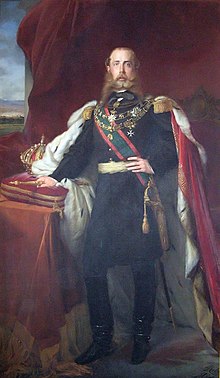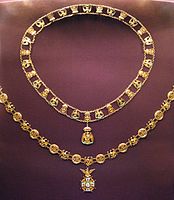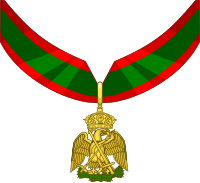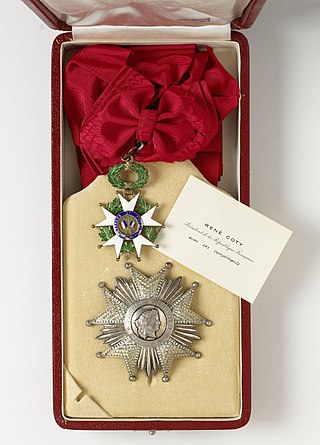
The National Order of the Legion of Honour, formerly the Royal Order of the Legion of Honour, is the highest French order of merit, both military and civil. Established in 1802 by Napoleon Bonaparte, it has been retained by all later French governments and regimes.

The Order of the White Eagle is the highest order of merit of the Republic of Poland and one of the oldest distinctions in the world still in use. It was officially instituted on 1 November 1705 by Augustus II the Strong, King of Poland and Elector of Saxony, and bestowed on eight of his closest diplomatic and political supporters. It has since been awarded to the most distinguished Poles for their merits and to the highest-ranking representatives of foreign countries.

The Order of the Iron Crown was an order of merit that was established on 5 June 1805 in the Kingdom of Italy by Napoleon Bonaparte under his title of Napoleon I, King of Italy.

The Order of the Dannebrog is a Danish order of chivalry instituted in 1671 by Christian V. Until 1808, membership in the Order was limited to fifty members of noble or royal rank, who formed a single class known as White Knights to distinguish them from the Blue Knights who were members of the Order of the Elephant. In 1808, the Order was reformed and divided into four classes. The statute of the Order was amended in 1951 by a Royal Ordinance so that both men and women could be members of the Order. Today, the Order of the Dannebrog is a means of honouring and rewarding the faithful servants of the modern Danish state for meritorious civil or military service, for a particular contribution to the arts, sciences or business life, or for working for Danish interests.

The Military Order of Christ is the former order of Knights Templar as it was reconstituted in Portugal. Before 1910, it was known as the Royal Military Order of Our Lord Jesus Christ, and the Order of the Knights of Our Lord Jesus Christ. It was founded in 1319, with the protection of King Denis of Portugal, after the Templars were abolished on 22 March 1312 by the papal bull, Vox in excelso, issued by Pope Clement V. King Denis refused to pursue and persecute the former knights as had occurred in most of the other sovereign states under the political influence of the Catholic Church.
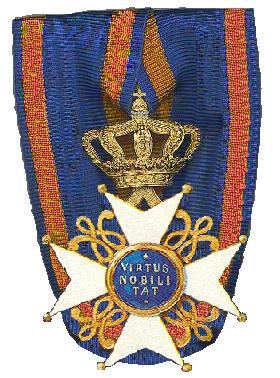
The Order of the Lion of the Netherlands, also known as the Order of the Netherlands Lion is a Dutch order of chivalry founded by King Willem I of the Netherlands on 29 September 1815.

The Order of the Crown is a house order of the Dutch Royal House. The order came into being as a result of Queen Juliana's reorganization of the Order of the House of Orange in 1969. The 18 classes of the house order were no longer felt to be appropriate in the ever more egalitarian Dutch society of the 1960s. The Order was divided into five subdivisions. As a house order it is not subject to ministerial responsibility or influence, but is awarded at the discretion of the Dutch monarch alone.

The Royal Order of the Sword is a Swedish order of chivalry and military decoration created by King Frederick I of Sweden on 23 February 1748, together with the Order of the Seraphim and the Order of the Polar Star. The motto of the order is in Latin: Pro Patria.

The Royal Norwegian Order of Saint Olav is a Norwegian order of chivalry instituted by King Oscar I on 21 August 1847. It is named after King Olav II, known to posterity as St. Olav.

The Order of Civil and Military Merit of Adolph of Nassau is an order of merit of the Grand Duchy of Luxembourg for meritorious service to the Grand Duke, the Grand-Ducal House and Luxembourg. It was founded in 1858 as a chivalric order of the Duchy of Nassau by Adolphe of Nassau in honor of his namesake and ancestor, Adolf, Count of Nassau, the only member of the House of Nassau to have been Roman King of Germany. After the Duchy of Nassau was annexed by Prussia in 1866 and Adolphe became Grand Duke of Luxembourg in 1890, he revived the order as an order of merit.

A necklet is a type of decoration which is designed to be worn and displayed around a person's neck, rather than hung (draped) from the chest as is the standard practice for displaying most decorations.

The Royal Order of the Polar Star, sometimes translated as the Royal Order of the North Star, is a Swedish order of chivalry created by King Frederick I on 23 February 1748, together with the Order of the Sword and the Order of the Seraphim. The Order of the Polar Star is intended as a reward for Swedish and foreign "civic merits, for devotion to duty, for science, literary, learned and useful works and for new and beneficial institutions".
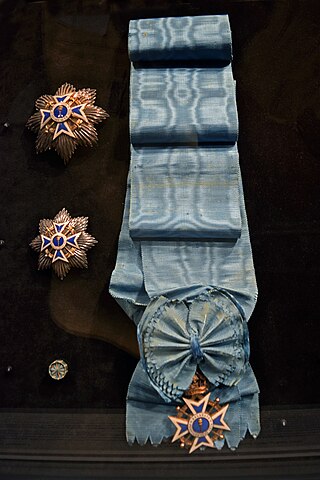
The Royal Order of Kalākaua I was instituted on 28 September 1874 by King Kalākaua I to commemorate his accession to the throne of the Kingdom of Hawaiʻi on 12 February 1874.

The Military Order of St. Henry was a military order of the Kingdom of Saxony, a member state of the German Empire. The order was the oldest military order of the states of the German Empire. It was founded on October 7, 1736 by Augustus III, King of Poland and Elector of Saxony. The order underwent several more revisions over the course of the 19th and early 20th centuries. It became obsolete with the fall of the Saxon monarchy in the wake of Germany's defeat in World War I.
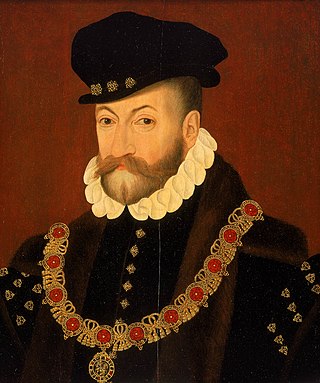
A collar, also known as collar of an order, is an ornate chain, often made of gold and enamel, and set with precious stones, which is worn about the neck as a symbol of membership in various chivalric orders. It is a particular form of the livery collar, the grandest form of the widespread phenomenon of livery in the Middle Ages and Early Modern Period. Orders which have several grades often reserve the collar for the highest grade. The links of the chain are usually composed of symbols of the order, and the badge of the order normally hangs down in front. Sometimes the badge is referred to by what is depicted on it; for instance, the badge that hangs from the chain of the Order of the Garter is referred to as "the George".

The Order of the Quetzal is Guatemala's highest honor.
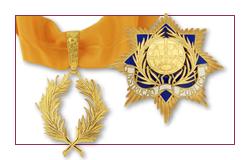
The Order of Public Instruction is a Portuguese order of civil merit. Established in 1927, it is conferred upon deserving individuals for "high services rendered to education and teaching."

The Order of Entrepreneurial Merit is the most junior of the Portuguese civil orders of merit, and is intended to distinguish those who have rendered, as an entrepreneur or worker, outstanding service in promoting appreciation or services in an economic sector. The Order has three categories: Agricultural, Commercial and Industrial; each of these correspond to specific related to the associated economic sectors, which is also reflected in the insignia of each category.

The House Order of Henry the Lion In German: Hausorden Heinrichs des Löwen, was the House Order of the Duchy of Brunswick. It was instituted by William VIII, Duke of Brunswick on 25 April 1834. The ribbon of the Order was red with yellow edges. It had five grades: Grand Cross, Grand Commander with Sash, Commander, Knight 1st Class, Knight 2nd Class, plus Medal of Merit for Science and Arts, the Cross of Merit and the Medal of Honour. The Order was named in honour of Henry the Lion, who remains a popular figure to this day.
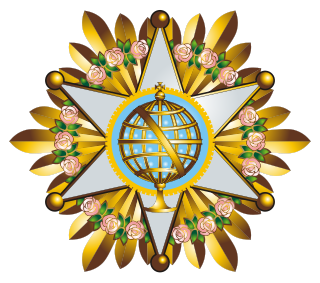
The National Order of Merit is a decoration created to reward Brazilian citizens over 25 years of age who have rendered services relevant to the Brazilian nation, and foreigners who, according to the government, are worthy of this distinction.


